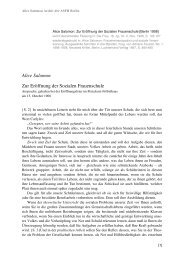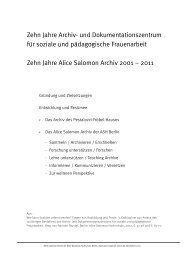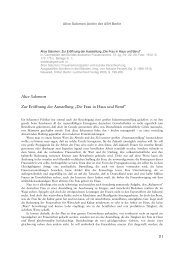Teaching Gender in Social Work - MailChimp
Teaching Gender in Social Work - MailChimp
Teaching Gender in Social Work - MailChimp
Create successful ePaper yourself
Turn your PDF publications into a flip-book with our unique Google optimized e-Paper software.
The Roots of the <strong>Social</strong> <strong>Work</strong> Profession as a Resource <strong>in</strong><br />
the Dialogical <strong>Teach<strong>in</strong>g</strong> of <strong>Gender</strong><br />
Mirja Satka and Johanna Moilanen<br />
Abstract<br />
This article addresses gender issues <strong>in</strong> social work, <strong>in</strong>clud<strong>in</strong>g gender order,<br />
gendered divisions at work and gender-specific local or national practices <strong>in</strong><br />
social work as historically and culturally reproduced phenomena. Our aim<br />
is to provide teachers with several dialogical ideas for mak<strong>in</strong>g history ‘come<br />
alive’ and to enlighten future professional actors about the deeply gendered<br />
cultural mean<strong>in</strong>gs of the profession. We present some pedagogical means <strong>in</strong> a<br />
discussion of how to address the issue of gender <strong>in</strong> teach<strong>in</strong>g by us<strong>in</strong>g historical<br />
narratives that have been written from a gender-conscious perspective as<br />
a resource. We put particular emphasis on the formation of gender-specific<br />
divisions of tasks <strong>in</strong> social work practice. A case study from F<strong>in</strong>land is presented<br />
as an example of how fem<strong>in</strong>ist historical scholarship can present opportunities<br />
for the <strong>in</strong>novative teach<strong>in</strong>g of gender. The case study is followed by an<br />
illustrative example of how to apply drama education <strong>in</strong> teach<strong>in</strong>g gender <strong>in</strong> a<br />
culturally and emotionally sensitive way. In addition, we suggest some other<br />
alternatives for teach<strong>in</strong>g based on various k<strong>in</strong>ds of historical documents and<br />
scholarly materials.<br />
Introduction<br />
Contemporary social issues are highly complex, globally <strong>in</strong>terrelated, and<br />
dynamic. <strong>Social</strong> workers have contradictory roles when deal<strong>in</strong>g with them:<br />
they have to act as <strong>in</strong>struments of government (the social control function)<br />
and as advocates of people oppressed by the policies of government and other<br />
authorities (the social change function). Under the present circumstances<br />
social workers must be able to draw upon many sources of <strong>in</strong>formation and<br />
different knowledge traditions. Accomplish<strong>in</strong>g this requires them to break out<br />
of the truths of objectify<strong>in</strong>g knowledge and the traditional meta-narratives of<br />
the profession. For this purpose, our substantial experience <strong>in</strong> teach<strong>in</strong>g social<br />
work courses has led us to develop <strong>in</strong>novative techniques and methods for<br />
teach<strong>in</strong>g, <strong>in</strong>stead of merely offer<strong>in</strong>g lectures on the pr<strong>in</strong>ciples of help<strong>in</strong>g people<br />
or hold<strong>in</strong>g sem<strong>in</strong>ar discussions on gender issues and social problems.<br />
35














